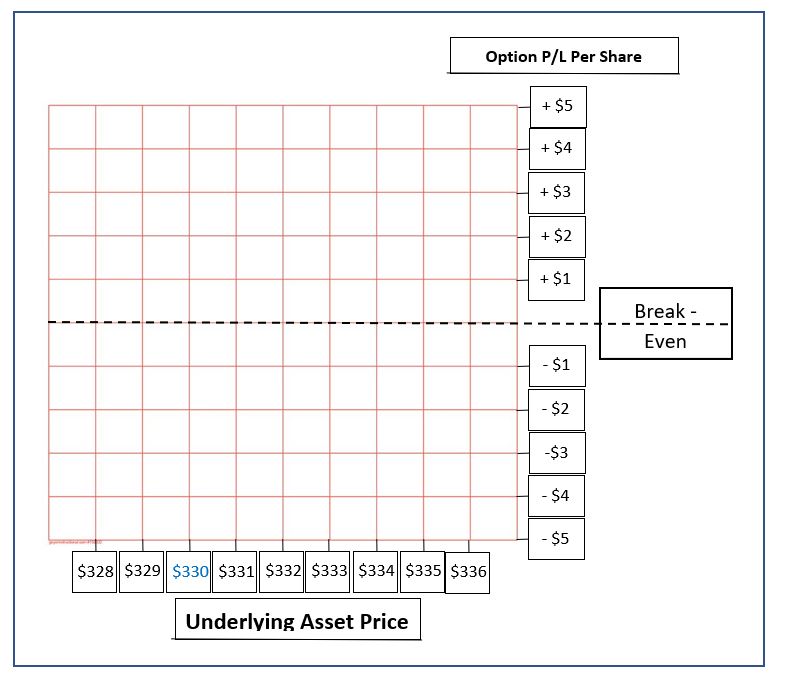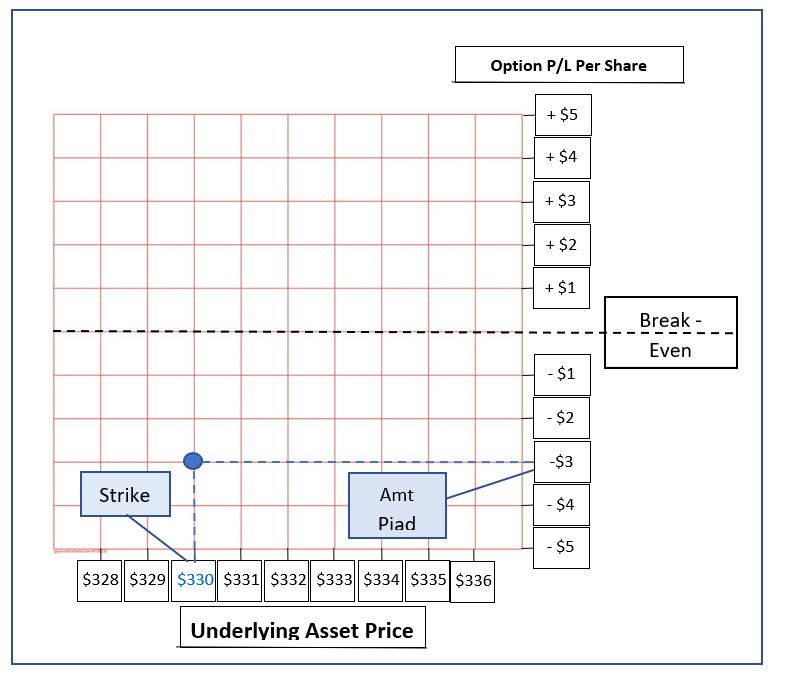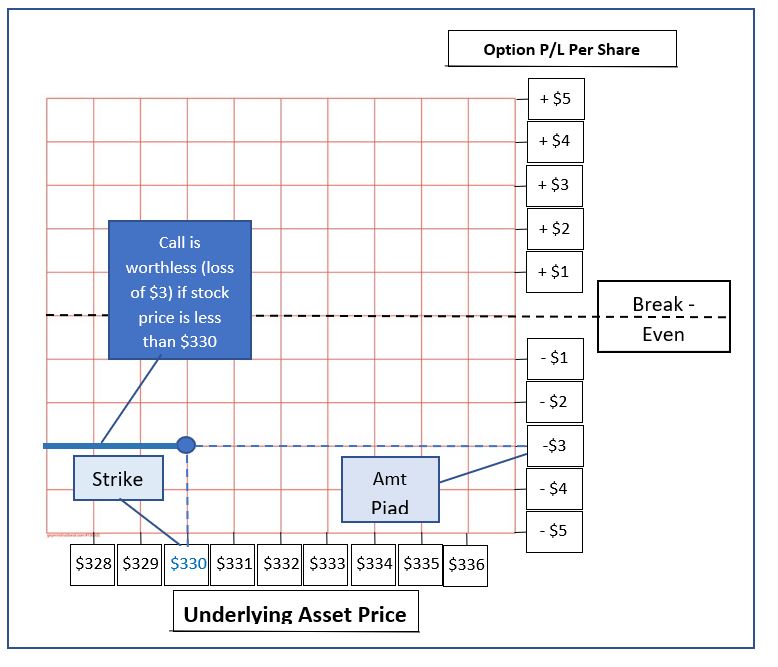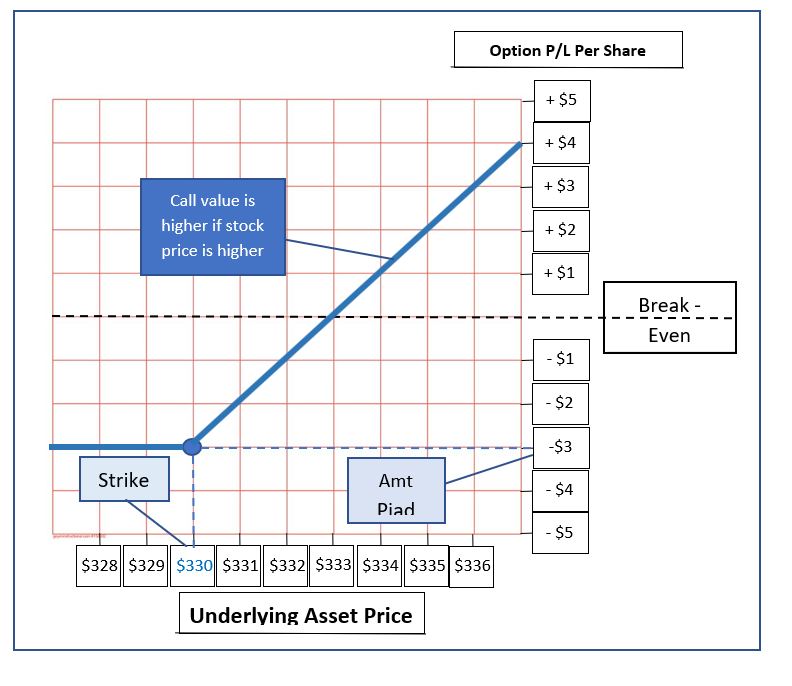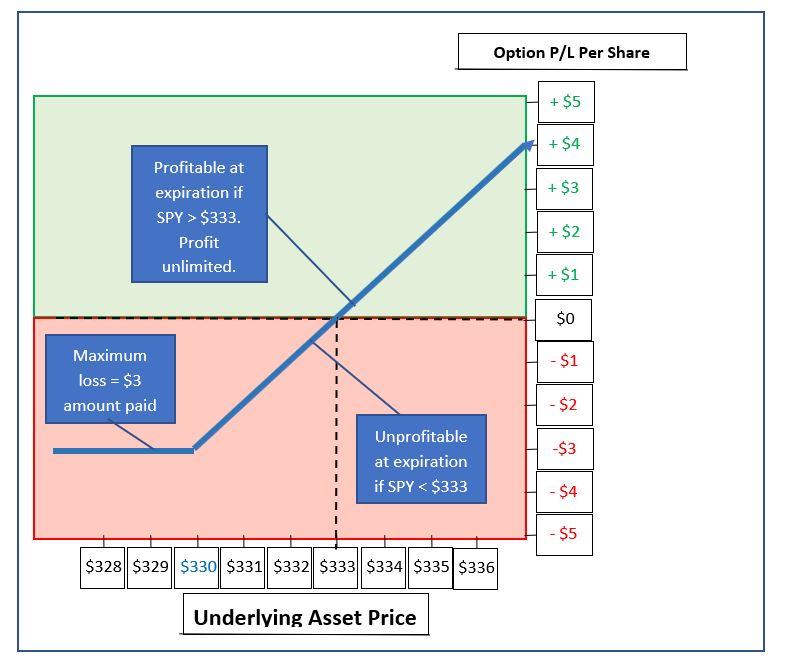An Option Profit/Loss Graph is the primary tool for option traders to calculate the potential profit or loss on an option position. We need to do this to decide whether the potential profit on an option trade is worth the risk.
Using the profit/loss graph is easy when you understand it, so here, I’ll show how to build one from scratch if there wasn’t a computer to do it for us. I’ll demonstrate how it was done in the covered wagon days, on a sheet of graph paper. This will make it easy to grasp how it works. (Note to millennials: paper is a substance with two flat surfaces and four straight edges, on which people used to make symbols with writing instruments called pencils, before the invention of screens).
Calculating Profit/Loss on Options
Let’s say, for the sake of example, that SPY closed today at $332 per share and I believe that it will go up further in the next few weeks (not a recommendation, just a for-instance).
I see that there are call options at the $330 strike price that expire in fourteen days. One of these call options gives me the right to buy SPY at $330 at any time within the two weeks. The options can be purchased for $3.00 per share today.
If I buy the calls today for $3.00, how much money can I make if SPY goes up by, say, $4.00 per share? Or any other amount?
Here’s an example with images of how to manually create an option profit/loss graph to calculate whether or not an option trade has viable profit potential:
Creating the Option Profit/Loss Graph (the old-fashioned way):
1. Laying Out the Option Profit/Loss Graph
-
Take out a sheet of graph paper
-
Label the horizontal axis Underlying Asset Price.
-
Label the vertical axis Option Profit/Loss per Share
-
Draw a horizontal line across the middle of the sheet, label it Break-Even
-
Across the bottom of the page, label grid squares with numbers representing the SPY per-share price, with the $332 current price in the center, looking left to right.
2. Plotting the Proposed Option Trade Entry
On the graph, place a dot where the strike price ($330) and the amount paid for the option (-$3.00) intersect.
3. Determining Loss if Price Is Below Strike Price at Expiration
Since this option trade example is a call, we will extend a line horizontally from the dot to the left edge of the chart. This shows that, upon expiration the loss would be equal to the amount paid for the option ($3), if at expiration the price was less than the $330 strike price by any amount ($0 – $330).If this trade were a put, the line would extend to the right edge of the chart to show that, upon expiration the loss would be equal to the amount paid for the option, if at expiration the price was more than the strike price by any amount.
4. Determining Potential Profit/Loss at Expiration
For this call example, we will draw a line from the dot diagonally upward to the right. This line should run straight through the intersections in the grid lines, as shown. This shows that if the stock price is higher than the call strike at expiration, the call’s value will be equal to the amount by which the stock price exceeds the strike.If we had used a put, this line would be drawn diagonally upward to the left in the same fashion to determine the potential profit/loss.
5. Reading the Option Profit/Loss Graph
The finished graph above shows the following:
-
The maximum loss on any option purchase is the amount paid, and this maximum loss occurs on an option held until expiration if the stock price then is such that the option is worthless. This is conveyed by the horizontal line at -$3 P/L stretching from stock prices of $330 across to zero (although prices below $328 are not shown on the graph in this example).
-
This is a bullish trade – one that rewards an upward move in the stock price. This is conveyed by the upward slope of the diagonal line. Higher stock prices (farther to the right) equal higher profit potential, as indicated by the increase in price as the diagonal line moves upward.
-
Profit/loss can be determined by doing the following:
-
Draw a vertical line upward from the horizontal axis at any underlying asset price (price of SPY) at which you want to evaluate the trade’s profitability, say $333. This horizontal reference line you just drew is called a price slice. In practice, computers draw them for us.
-
From the point where the price slice intersects the blue diagonal line, draw a new horizontal line to the right, all the way to the vertical axis.
-
The value at which your newly-drawn horizontal line intersects with the vertical axis shows the profit or loss per share on the option trade, if the stock were to be at the price indicated at expiration.
-
Starting from an underlying asset price of $333, this process gives a value of $0 per share P/L. This indicates that if SPY is at $333 at expiration, the trade will break-even. A line drawn upward from $335 would intersect the P/L line at a P/L axis value of +$2.00, indicating a $2.00 profit, and so on.
-
-
Using the same logic, it is now easy to see that if the stock is at any price below $330 at expiration, the maximum loss of -$3.00 per share will be the result.
-
And, if the stock is between $330 and $333, there will be a loss on the trade of from $0 to -$3.00.
-
Finally, if the stock were to be at any price higher than $333, then there will be a profit on the trade, equal to the amount by which the stock exceeds $333, with no limit on profit.
The construction of these graphs is elementary, but very useful. This is just the beginning of what an option profit/loss graph can tell us. I hope that this step-by-step description makes learning how to use an option profit/loss graph easier.
This content is intended to provide educational information only. This information should not be construed as individual or customized legal, tax, financial or investment services. As each individual's situation is unique, a qualified professional should be consulted before making legal, tax, financial and investment decisions. The educational information provided in this article does not comprise any course or a part of any course that may be used as an educational credit for any certification purpose and will not prepare any User to be accredited for any licenses in any industry and will not prepare any User to get a job. Reproduced by permission from OTAcademy.com click here for Terms of Use: https://www.otacademy.com/about/terms
Editors’ Picks

EUR/USD attacks 1.0800 ahead of EU inflation data
EUR/USD is battling 1.0800 in the early European session on Tuesday, undermined by the latest US Dollar bounce. Traders keenly await the EU inflation data and the US jobs survey for further impetus as US President Trump's 'reciprocal tariffs' announcement looms on Wednesday.

GBP/USD treads water above 1.2900 ahead of US data, tariffs
GBP/USD is trading on the defensive while holding above 1.2900 in Tuesday's European trading. The pair loses ground amid a modest US Dollar uptick as traders resort to repositioning in the lead-up to the top-tier US economic data releases and Wednesday's tariffs announcements.

Gold price eases from record high; bullish bias remains amid worries over Trump's tariffs
Gold price retreats slightly after touching a fresh all-time high on Tuesday as bulls pause for a breather and opt to wait for US President Donald Trump's reciprocal tariffs announcement. Adding to this, a positive tone around the Asian equity markets also acts as a headwind for the commodity amid overbought conditions on the daily chart.

PEPE could rally to double digits if it breaks above its key resistance level
Pepe memecoin approaches its descending trendline, trading around $0.000007 on Tuesday; a breakout indicates a bullish move ahead. Moreover, PEPE's long-to-short ratio supports a bullish thesis as bullish bets among the traders reach the highest over a month.

Is the US economy headed for a recession?
Leading economists say a recession is more likely than originally expected. With new tariffs set to be launched on April 2, investors and economists are growing more concerned about an economic slowdown or recession.
RECOMMENDED LESSONS
Making money in forex is easy if you know how the bankers trade!
Discover how to make money in forex is easy if you know how the bankers trade!
5 Forex News Events You Need To Know
In the fast moving world of currency markets, it is extremely important for new traders to know the list of important forex news...
Top 10 Chart Patterns Every Trader Should Know
Chart patterns are one of the most effective trading tools for a trader. They are pure price-action, and form on the basis of underlying buying and...
7 Ways to Avoid Forex Scams
The forex industry is recently seeing more and more scams. Here are 7 ways to avoid losing your money in such scams: Forex scams are becoming frequent. Michael Greenberg reports on luxurious expenses, including a submarine bought from the money taken from forex traders. Here’s another report of a forex fraud. So, how can we avoid falling in such forex scams?
What Are the 10 Fatal Mistakes Traders Make
Trading is exciting. Trading is hard. Trading is extremely hard. Some say that it takes more than 10,000 hours to master. Others believe that trading is the way to quick riches. They might be both wrong. What is important to know that no matter how experienced you are, mistakes will be part of the trading process.

The Best brokers to trade EUR/USD
SPONSORED Discover the top brokers for trading EUR/USD in 2025. Our list features brokers with competitive spreads, fast execution, and powerful platforms. Whether you're a beginner or an expert, find the right partner to navigate the dynamic Forex market.
